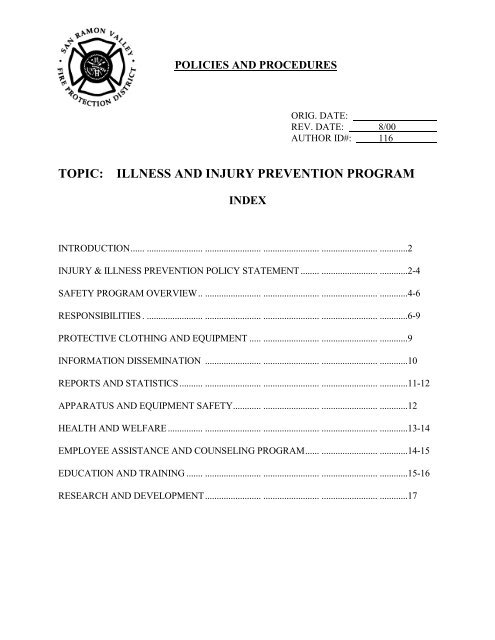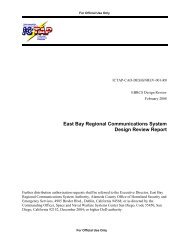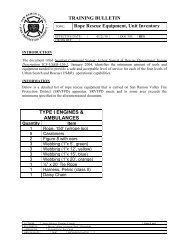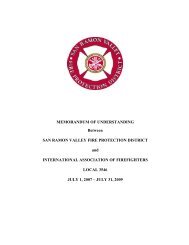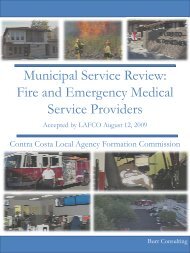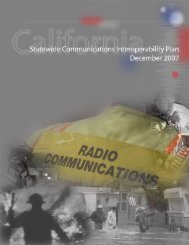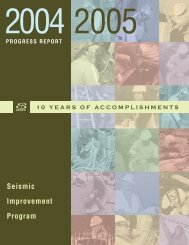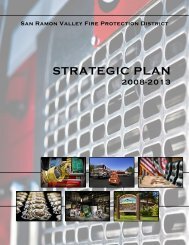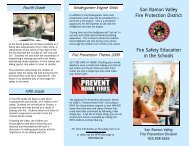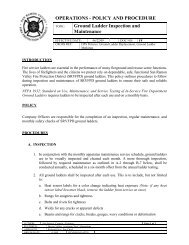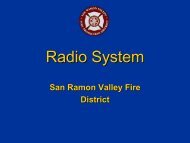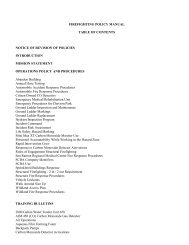topic: illness and injury prevention program - San Ramon Valley Fire
topic: illness and injury prevention program - San Ramon Valley Fire
topic: illness and injury prevention program - San Ramon Valley Fire
You also want an ePaper? Increase the reach of your titles
YUMPU automatically turns print PDFs into web optimized ePapers that Google loves.
POLICIES AND PROCEDURES<br />
ORIG. DATE:<br />
REV. DATE: 8/00<br />
AUTHOR ID#: 116<br />
TOPIC:<br />
ILLNESS AND INJURY PREVENTION PROGRAM<br />
INDEX<br />
INTRODUCTION...... ........................ ........................ ........................ ........................ ............2<br />
INJURY & ILLNESS PREVENTION POLICY STATEMENT ........ ........................ ............2-4<br />
SAFETY PROGRAM OVERVIEW.. ........................ ........................ ........................ ............4-6<br />
RESPONSIBILITIES . ........................ ........................ ........................ ........................ ............6-9<br />
PROTECTIVE CLOTHING AND EQUIPMENT ..... ........................ ........................ ............9<br />
INFORMATION DISSEMINATION ........................ ........................ ........................ ............10<br />
REPORTS AND STATISTICS.......... ........................ ........................ ........................ ............11-12<br />
APPARATUS AND EQUIPMENT SAFETY............ ........................ ........................ ............12<br />
HEALTH AND WELFARE............... ........................ ........................ ........................ ............13-14<br />
EMPLOYEE ASSISTANCE AND COUNSELING PROGRAM...... ........................ ............14-15<br />
EDUCATION AND TRAINING ....... ........................ ........................ ........................ ............15-16<br />
RESEARCH AND DEVELOPMENT........................ ........................ ........................ ............17
ILLNESS AND INJURY PREVENTION PROGRAM<br />
INTRODUCTION:<br />
<strong>Fire</strong>fighting is one of the most dangerous occupations in the country. Thous<strong>and</strong>s of firefighters are<br />
injured in the line of duty <strong>and</strong> hundreds more are forced to retire due to occupational diseases <strong>and</strong><br />
disabilities. Statistics reveal almost two hundred lose their lives each year in the line of duty.<br />
Because statistics <strong>and</strong> research reveal many occupational accidents <strong>and</strong> <strong>illness</strong>es are preventable<br />
through an effective education <strong>and</strong> training <strong>program</strong>, the California Occupational Safety <strong>and</strong> Health<br />
Act (CAL/OSHA) of 1973 <strong>and</strong> SB 198 was enacted to ensure that California workers receive such<br />
<strong>program</strong>s.<br />
PROCEDURE:<br />
General Industry Safety Order (GISO) #3203 requires each employer to establish <strong>and</strong> maintain an<br />
accident <strong>and</strong> <strong>illness</strong> <strong>prevention</strong> <strong>program</strong> for employee protection. This <strong>program</strong> must include but<br />
not be limited to:<br />
1. Training for employee in general safe work practices.<br />
2. Specific instruction for employees in hazards unique to each employee's work<br />
assignment.<br />
3. Schedule periodic inspections of the work place to identify unsafe conditions <strong>and</strong><br />
work practices. The employer is to correct unsafe conditions <strong>and</strong> work practices<br />
found as a result of these inspections.<br />
The <strong>San</strong> <strong>Ramon</strong> <strong>Valley</strong> <strong>Fire</strong> Protection District (SRVFPD) recognizes the health <strong>and</strong> safety issues<br />
of their personnel, <strong>and</strong> with the expansion of minimum elements required by OSHA, will develop<br />
<strong>and</strong> maintain a specialized <strong>and</strong> comprehensive accident <strong>and</strong> <strong>illness</strong> <strong>prevention</strong> <strong>program</strong>.<br />
Development <strong>and</strong> conscientious implementation of such a <strong>program</strong> will reduce accidents, <strong>illness</strong>es,<br />
property damage <strong>and</strong> will result in higher efficiency at a reduced rate.<br />
It is the intention of this district to employ, train, educate <strong>and</strong> maintain as high a degree of safety<br />
<strong>and</strong> health provisions for its employees as possible.<br />
The overall goal will be to ensure that our personnel reach retirement in as healthy a condition as<br />
possible, through accident <strong>prevention</strong> <strong>and</strong> sound health <strong>and</strong> fitness <strong>program</strong>s.<br />
1. It is the policy of the <strong>San</strong> <strong>Ramon</strong> <strong>Valley</strong> <strong>Fire</strong> Protection District to provide training,<br />
equipment, policies <strong>and</strong> systems to prevent accidents, <strong>and</strong> to protect employees from<br />
job related injuries <strong>and</strong> <strong>illness</strong>.<br />
2. The <strong>San</strong> <strong>Ramon</strong> <strong>Valley</strong> <strong>Fire</strong> Protection District will maintain an <strong>injury</strong> <strong>and</strong> <strong>illness</strong><br />
<strong>prevention</strong> <strong>program</strong> consisting of the following elements:<br />
Page 2 of 17
a. Regular inspections of equipment <strong>and</strong> facilities for health <strong>and</strong> safety hazards.<br />
b. Training <strong>and</strong> instruction of personnel in the use <strong>and</strong> hazards of equipment,<br />
facilities <strong>and</strong> safety hazards for employees' functional job assignments.<br />
c. A system of communicating with employees on health <strong>and</strong> safety matters.<br />
d. A method for employees to report safety <strong>and</strong> health hazards.<br />
e. A Safety Committee to study causes of on the job accidents <strong>and</strong> safety<br />
complaints <strong>and</strong> to make recommendations for correction.<br />
f. Permanent files of employee injuries, records of exposure to toxic <strong>and</strong><br />
hazardous substances, medical examinations, employee training, accident<br />
<strong>and</strong> safety inspection records <strong>and</strong> actions taken to correct safety hazards.<br />
g. A sound mental <strong>and</strong> physical fitness <strong>program</strong>.<br />
3. The <strong>Fire</strong> Chief shall be responsible for maintaining a safe working environment <strong>and</strong><br />
for implementing an <strong>injury</strong> <strong>and</strong> <strong>illness</strong> <strong>prevention</strong> <strong>program</strong> for all employees.<br />
4. The Safety Administrator shall be responsible for coordinating the Injury <strong>and</strong> Illness<br />
Prevention Program.<br />
5. Supervisors will be responsible for conducting regular <strong>and</strong> periodic inspections of<br />
equipment <strong>and</strong> facilities, to identify work site hazards <strong>and</strong> unsafe working<br />
conditions, <strong>and</strong> to make recommendations for correction of hazards.<br />
6. <strong>Fire</strong> Captains will be responsible to train personnel in <strong>Fire</strong> District safety procedures<br />
<strong>and</strong> to enforce District safety regulations <strong>and</strong> orders.<br />
7. All Employees are responsible for complying with safety orders <strong>and</strong> policies<br />
established by the <strong>Fire</strong> District. Pursuant to Administrative Procedures, Rules <strong>and</strong><br />
Regulations <strong>and</strong>/or existing Memor<strong>and</strong>um of Underst<strong>and</strong>ing, violation of District<br />
safety regulations or orders may result in disciplinary action.<br />
8. The <strong>Fire</strong> District shall provide protective clothing <strong>and</strong> equipment for each employee<br />
whose duties require said clothing <strong>and</strong> equipment. Employees are responsible for<br />
maintaining protective clothing <strong>and</strong> equipment in clean <strong>and</strong> operable conditions at<br />
all times, <strong>and</strong> to use such equipment when required by District policy.<br />
9. Policies <strong>and</strong> Procedures relating to safety will be available for all employees to<br />
review.<br />
10. Specific Bulletin Board space will be maintained at each work site to inform<br />
employees about safety related matters.<br />
Page 3 of 17
DIVISION:<br />
11. Employees are encouraged to report any <strong>and</strong> all unsafe working conditions or<br />
practices without fear of reprisal. Employees may report, anonymously if they<br />
desire, unsafe working conditions or practices to their supervisor or the Safety<br />
Committee, on appropriate district forms.<br />
12. A Safety Committee consisting of District employees <strong>and</strong> Administration<br />
representatives will meet regularly to review, investigate <strong>and</strong> recommend action as<br />
necessary on the following items:<br />
a. Work Site Inspection Records<br />
b. Employee Safety Inspection Requests <strong>and</strong> Suggestions<br />
c. Accident, Injury <strong>and</strong> Illness Reports <strong>and</strong> Records<br />
d. Employee Health <strong>and</strong> Safety Training Programs<br />
e. <strong>Fire</strong> District Safety Orders, Policies <strong>and</strong> Procedures<br />
13. The Duty Battalion Chief for each shift will take action as necessary to correct<br />
safety hazards <strong>and</strong>/or amend District Safety Policy in a timely manner as health<br />
<strong>and</strong> safety hazards are identified.<br />
Safety Program Overview<br />
STRUCTURE:<br />
SYSTEMS:<br />
The <strong>program</strong> will, under the direction of the Assistant Chief of Safety Division, consist of a<br />
Safety Committee composed of a Program Coordinator, Functional Supervisor (Committee<br />
Chair) <strong>and</strong> an undetermined number of members; sufficient to h<strong>and</strong>le department's<br />
objectives <strong>and</strong> sub-committees.<br />
Systems design will provide for securing information <strong>and</strong> awareness to all personnel in the<br />
areas of health-fitness <strong>and</strong> safety. The systems devised must focus on daily safety<br />
awareness. Special attention will be given to new employees upon their arrival, <strong>and</strong><br />
subsequent years of service.<br />
1. Information-dissemination, bulletin boards established <strong>and</strong> maintained<br />
2. N.A.F.E.R.S. Membership<br />
3. OSHA - Develop Communication <strong>and</strong> use as technical advisors<br />
4. Periodic officers meetings with a focus on safety<br />
5. Investigations - Accidents - Health Problems - Fitness -Etc.<br />
6. Professional Intervention - Employee assistance <strong>program</strong><br />
Page 4 of 17
STAFFING:<br />
SKILLS:<br />
7. Regular Safety Committee Meetings - To track our progress<br />
8. A structured training <strong>program</strong><br />
Our Safety Division will be a cross section of personnel assigned to a sub-committee with<br />
specialized tasks. It will consist of two or more members per sub-committee, including, but<br />
not limited to:<br />
1. Protective clothing <strong>and</strong> equipment<br />
2. Information dissemination<br />
3. Reports <strong>and</strong> statistics<br />
4. Apparatus <strong>and</strong> emergency equipment<br />
5. Health, welfare <strong>and</strong> physical fitness<br />
6. Employee assistance <strong>and</strong> counseling<br />
7. Education <strong>and</strong> training<br />
8. Research <strong>and</strong> development<br />
All line <strong>and</strong> staff members will be trained in areas of proper safety practices, fitness <strong>and</strong><br />
health skills. Training will be accomplished through a variety of methods listed below:<br />
1. Seminars<br />
2. Written materials<br />
3. Research <strong>and</strong> Development<br />
4. Professional Resources - Doctors - Dieticians - Employee Assistance<br />
PROGRAM STYLE:<br />
Due to the broad categories involved in a total health <strong>and</strong> safety <strong>program</strong>, the <strong>program</strong> style<br />
must also be broad in its administration. All data gathered in reference to health <strong>and</strong> safety<br />
must be analytical in nature.<br />
Page 5 of 17
SHARED VALUES:<br />
The public cannot be served by unhealthy or unfit individuals or organizations. All<br />
personnel must realize that without exception, safety <strong>and</strong> health extends itself into three<br />
general areas. The physical health <strong>and</strong> fitness; intellectual health <strong>and</strong> fitness; <strong>and</strong> our<br />
emotional (feelings) health <strong>and</strong> fitness. These areas are interconnected <strong>and</strong> must be<br />
approached as such, if our values as members of this organization are to be shared.<br />
Hence, by all personnel sharing in these values, we can be assured of healthy personnel up<br />
to <strong>and</strong> during retirement.<br />
RESPONSIBILITIES<br />
Employee safety is a district goal. Not only do employee injuries interfere with orderly<br />
functioning of the organization but also, disabilities <strong>and</strong> deaths can cause substantial<br />
personal <strong>and</strong> monetary loss.<br />
FIRE CHIEF: Evaluate the results of the <strong>program</strong> constantly <strong>and</strong> continuously.<br />
SAFETY ADMINISTRATOR (Administrative Assistant Chief):<br />
1. Assign responsibility for accident <strong>prevention</strong> including describing the duties <strong>and</strong><br />
responsibilities of the <strong>program</strong> coordinator, line supervisors, safety committee <strong>and</strong><br />
employees.<br />
2. Establish realistic goals <strong>and</strong> periodically revise them to ensure continuous <strong>and</strong><br />
maximum <strong>program</strong> effectiveness.<br />
3. Evaluate the results of the <strong>program</strong> constantly <strong>and</strong> continuously.<br />
PROGRAM COORDINATOR (Battalion Chief, Training):<br />
His role includes the following:<br />
1. Establishing objectives to accomplish district goals.<br />
2. Monitor safety committee's activities to maintain proper direction.<br />
3. Attend safety meetings to maintain communications between safety committee <strong>and</strong><br />
management.<br />
4. Add or delete committee staffing as needed, to accomplish District's objectives.<br />
5. Establish quality control systems.<br />
6. Receive committee's accident <strong>injury</strong> reports <strong>and</strong> act in accordance within<br />
jurisdictional guidelines.<br />
Page 6 of 17
7. Rotate sub-committee members to ensure balance, maximum use of expertise <strong>and</strong><br />
stimulate interest.<br />
As Chairman of Safety Committee he/she will:<br />
1. Schedule safety meetings.<br />
2. Attend seminars <strong>and</strong> designate sub-committee's attendance to those pertinent to their<br />
division.<br />
3. Assign committee members to investigate accidents.<br />
4. Revise <strong>and</strong> update safety <strong>program</strong> guide.<br />
5. Review <strong>and</strong> update administrative bulletins, S.O.P.'s <strong>and</strong> information sheets<br />
concerning health <strong>and</strong> safety.<br />
6. Coordinate annual inspection of personnel's protective clothing in April of each<br />
year.<br />
BATTALION CHIEFS, DIVISION SUPERVISORS:<br />
Each Battalion Chief must accept responsibility for safety activities within their division.<br />
Their duties should be within the context of the District's goals <strong>and</strong> objectives. They will:<br />
1. Communicate management's goals to supervisors.<br />
2. Observe, evaluate <strong>and</strong> counsel with supervisors. Retrain where indicated.<br />
3. Train new supervisors.<br />
4. Review accident reports on their respective shifts <strong>and</strong> sign appropriately prior to<br />
routing to Personnel (Re: Captains <strong>and</strong> Acting Captains).<br />
5. Receive <strong>and</strong> review accident reports from all personnel on respective shifts.<br />
6. Implement the correction of any unsafe conditions as they arise utilizing direct<br />
action <strong>and</strong> if necessary, referral to safety committee, etc.<br />
7. Communicate district safety problems to management <strong>and</strong> provide feedback.<br />
COMPANY COMMANDERS:<br />
This being the first level of supervision, employee behavior regarding safety should<br />
receive the utmost attention. They will:<br />
1. Stimulate interest in safe work habits through personal example.<br />
Page 7 of 17
2. Supervise <strong>and</strong> evaluate employee performance.<br />
3. Observe <strong>and</strong> correct unsafe employee acts through training.<br />
4. Should a safety problem be identified, implement corrective action A.S.A.P. Assess<br />
problem thoroughly, determine its volatility, then act on it.<br />
5. Report <strong>and</strong> investigate all injuries by employees under their supervision.<br />
6. Carry on continuous safety training with all employees under their direction.<br />
7. Conduct regularly scheduled safety meetings.<br />
ALL EMPLOYEES:<br />
With special reference to safety, employees will, as part of their condition of employment:<br />
1. Perform their jobs in accordance with established safe procedures, recognizing<br />
responsibility for their own safety <strong>and</strong> that of fellow employees.<br />
2. Report all injuries <strong>and</strong> near misses to supervisor.<br />
3. Report all observed hazards <strong>and</strong> institute their elimination.<br />
4. Actively participate in the health <strong>and</strong> safety <strong>program</strong>.<br />
SAFETY COMMITTEE:<br />
Safety Committee members are required to attend <strong>and</strong> participate in all scheduled meetings.<br />
Members are to notify the Program Coordinator if they will be absent. The next employee<br />
on the Safety Committee eligibility list will replace any member missing 3 meetings in a<br />
row or 5 in one year.<br />
Safety Committee members will:<br />
1. Recommend the adoption of safety policies <strong>and</strong> procedures to management.<br />
2. Participate in developing safety training <strong>program</strong>s.<br />
3. Review accident statistics <strong>and</strong> <strong>injury</strong> reports, in order to identify accident trends<br />
<strong>and</strong> make recommendations for correction.<br />
4. Review specific <strong>injury</strong> case histories where warranted.<br />
5. Provide feedback from personnel to committee.<br />
6. Function as members in one of the following categories:<br />
Page 8 of 17
A. Protective clothing <strong>and</strong> equipment<br />
B. Information dissemination<br />
C. Reports <strong>and</strong> statistics<br />
D. Apparatus <strong>and</strong> emergency equipment<br />
E. Health, welfare <strong>and</strong> physical fitness<br />
F. Employee assistance<br />
G. Education <strong>and</strong> training<br />
H. Research <strong>and</strong> development<br />
DIVISION:<br />
Protective Clothing <strong>and</strong> Equipment<br />
INTRODUCTION:<br />
One of the most important contributions to protecting a firefighter is providing guidance on<br />
adequate protective clothing <strong>and</strong> equipment. A firefighter's protective equipment is the<br />
primary defense against the hazardous environment in which he/she works.<br />
The <strong>San</strong> <strong>Ramon</strong> <strong>Valley</strong> <strong>Fire</strong> Protection District regards training in safety consciousness,<br />
awareness, protective clothing <strong>and</strong> equipment the most important aspect of firefighting <strong>and</strong><br />
other emergencies.<br />
The wearing, use <strong>and</strong> maintenance of protective clothing <strong>and</strong> equipment is both the<br />
District's <strong>and</strong> the individual's responsibility. Many firefighters have been injured needlessly<br />
due to non-use or carelessly using his or her protective equipment. Through training,<br />
research <strong>and</strong> established procedures, each member of the District can eliminate possible<br />
injuries.<br />
OBJECTIVES:<br />
1. To establish a written procedure covering the proper use <strong>and</strong> wearing of safety<br />
equipment as required in the orders of the Occupational Safety <strong>and</strong> Health St<strong>and</strong>ards<br />
Board, Title 8, CAL/OSHA.<br />
2. To establish proper maintenance of safety equipment using manufacturer's<br />
recommendations or District S.O.P.<br />
3. To establish procedures for replacement of equipment through District S.O.P. <strong>and</strong><br />
by determination of Company Officer.<br />
Page 9 of 17
DIVISION:<br />
Information Dissemination<br />
INTRODUCTION:<br />
Information dissemination should be regarded as one of the most valuable tools in the<br />
success of any <strong>program</strong>. Too often important data is only passed to <strong>and</strong> from parties<br />
involved. Wide distribution of statistics, safety information, results of accidents, etc. will be<br />
<strong>San</strong> <strong>Ramon</strong> <strong>Valley</strong>'s way of advertising <strong>and</strong> exposing all employees to pertinent<br />
information.<br />
OBJECTIVES:<br />
SYSTEM:<br />
1. Establish <strong>and</strong> maintain a Safety Bulletin Board for all work places.<br />
2. To maintain current posting of safety information.<br />
3. To increase overall awareness of the importance of safety.<br />
The Bulletin Board will be of a size no less than 48" x 48". It will be divided into several<br />
sections. Each section will have a specific heading.<br />
Information to be posted shall be sent to the stations on a periodic basis in the form of a<br />
packet.<br />
The work place supervisor will be responsible for making sure the information is posted.<br />
Each piece of information will have a disposition stating "Post on Safety Bulletin Board.<br />
Read <strong>and</strong> place in Operations Safety Guide Section, etc.".<br />
CONCLUSION:<br />
All personnel will receive the valuable information as it is disbursed. Furthermore, we must<br />
be able to retrieve it when needed for review or reference. By maintaining our Bulletin<br />
Boards <strong>and</strong> Operations Procedures Safety Guide <strong>and</strong> Intranet, we will accomplish this<br />
objective.<br />
Page 10 of 17
DIVISION:<br />
Reports <strong>and</strong> Statistics<br />
INTRODUCTION:<br />
A structured <strong>program</strong> of inspection, reporting <strong>and</strong> review is necessary to thoroughly<br />
analyze the members work place in relation to unsafe acts <strong>and</strong>/or conditions.<br />
OBJECTIVES:<br />
SYSTEM:<br />
1. Identify existing or suspected safety hazards in the work place, on the training<br />
ground, on the fire ground, during inspections, <strong>and</strong> while performing all other<br />
duties.<br />
2. Provide a vehicle to review reports of unsafe or hazardous conditions or acts <strong>and</strong><br />
recommend necessary corrections.<br />
3. To inform all personnel of any unsafe acts or conditions to prevent accidents <strong>and</strong><br />
injuries.<br />
4. To provide a means to report unsafe acts or conditions even if any <strong>injury</strong> has not<br />
yet occurred. (near misses)<br />
5. To provide a procedure to request a change in methods or procedures if they are<br />
thought to be unsafe, dangerous or hazardous.<br />
6. To provide a system to study records <strong>and</strong> reports of injuries as a means to prevent<br />
future accidents <strong>and</strong> injuries.<br />
This division will rely on information derived from the Supervisors meetings, utilizing<br />
safety or health action request as well as information from <strong>injury</strong> reports, to analyze<br />
conditions, acts, <strong>and</strong> accidents. This information will be reviewed by personnel <strong>and</strong><br />
committees to reduce <strong>and</strong> prevent future accidents.<br />
EMPLOYEE SAFETY INFORMATION FORM:<br />
An Employee Safety Information Form request will be completed by any member of the<br />
District upon discovery of an unsafe act or condition. This may be in addition to reporting<br />
items found during monthly safety inspections. Once completed, the form is sent to the<br />
Safety Committee Coordinator for processing. Should this process unduly delay a need for<br />
more prompt attention, the On-Duty Battalion Chief must be notified. The identity of the<br />
reporting party <strong>and</strong> the signing of the form by the reporting party is optional.<br />
Page 11 of 17
CONCLUSION:<br />
DIVISION:<br />
Once information is received <strong>and</strong> studied <strong>and</strong> solutions developed, the goal will be to<br />
significantly reduce injuries to the personnel of the District.<br />
Apparatus <strong>and</strong> Equipment Safety<br />
INTRODUCTION:<br />
The purpose of this division is to assimilate available information of apparatus accidents<br />
<strong>and</strong> how to prevent them.<br />
Determining what causes accidents is the first step in planning measures to prevent future<br />
accidents.<br />
OBJECTIVES:<br />
SYSTEM:<br />
1. Identify existing safety hazards or suspected hazards involving apparatus or<br />
equipment.<br />
2. Research any new equipment or related practices that may be safer than we currently<br />
use.<br />
3. Recommend change in District policy, apparatus modification or equipment<br />
purchases if research <strong>and</strong> development information is conducive to District needs.<br />
1 . Through accident investigation or letters of concern from personnel, problem areas<br />
will be identified.<br />
2. By attending safety classes, seminars <strong>and</strong> keeping abreast of current publications<br />
<strong>and</strong> bulletins, new equipment <strong>and</strong> practices may be studied for our possible use.<br />
3. Through the findings of accident investigation <strong>and</strong> the research of the new<br />
equipment <strong>and</strong> practices, recommendations may be made.<br />
CONCLUSION:<br />
Once information has been researched <strong>and</strong> preventative measures have been developed, the<br />
results will be presented to the members through the Training Division. This information<br />
may also be forwarded to the apparatus committee for their consideration with regard to<br />
apparatus modification or purchase.<br />
Page 12 of 17
DIVISION:<br />
Health <strong>and</strong> Welfare<br />
INTRODUCTION:<br />
Statistics show there is a direct correlation between firefighter injuries <strong>and</strong> physical<br />
conditioning. The biggest problems in implementing physical fitness <strong>program</strong>s has been the<br />
attitude of employees towards the <strong>program</strong> itself.<br />
To combat this problem, <strong>San</strong> <strong>Ramon</strong> <strong>Valley</strong> <strong>Fire</strong> has made it possible for each employee to<br />
engage in an exercise <strong>program</strong> daily. The <strong>program</strong> is designed to develop <strong>and</strong> maintain an<br />
adequate cardiovascular fitness level. Also, it is essential, due to the nature of the<br />
occupation to be properly conditioned to meet stress dem<strong>and</strong>s as well as engage in proper<br />
eating habits <strong>and</strong> weight control. In important part of the overall goal.<br />
OBJECTIVES:<br />
SYSTEM:<br />
1. Make each employee aware of the importance of health & fitness.<br />
2. Encourage smoking elimination.<br />
3. Stress management.<br />
4. Develop fitness levels for all employees.<br />
5. Develop employee physical conditioning awareness.<br />
6. Direct employees to professional <strong>and</strong> medical counseling assistance.<br />
1. Widely advertise <strong>program</strong> through posters, films, <strong>and</strong> seminars.<br />
2. Disseminate dietary information.<br />
3. Encourage <strong>and</strong> direct employees to utilize Employee Assistance Program (EAP)<br />
where applicable.<br />
4. Include a health <strong>and</strong> welfare session in firefighter recruit training.<br />
5. Stress need for complete physical <strong>and</strong> require when appropriate.<br />
Page 13 of 17
CONCLUSION:<br />
DIVISION:<br />
The overall goal of the health <strong>and</strong> welfare <strong>program</strong> is to have each employee reach <strong>and</strong><br />
maintain a maintenance level of fitness. To be successful, the <strong>program</strong> needs the support<br />
<strong>and</strong> participation of all levels of fire department organization. Effective supervision of the<br />
<strong>program</strong> is also essential. The intent of the <strong>program</strong> should not be to "weed" out unfit<br />
employees, but to bring all employees into compliance with physical st<strong>and</strong>ards. All<br />
employees will be made aware of various assistance <strong>program</strong>s available <strong>and</strong> encouraged to<br />
participate.<br />
Employee Assistance & Counseling Program<br />
INTRODUCTION:<br />
No one gets through adult life without problems. Many times, the way we h<strong>and</strong>le these<br />
problems result in more stress <strong>and</strong> make the problems worse. Not recognizing or dealing<br />
with these problems can lead to more serious consequences. The heaviest burden of<br />
concern can be eased if the problem can be shared by a trained professional counselor.<br />
OBJECTIVES:<br />
SYSTEM:<br />
1. To ensure all personnel <strong>and</strong> their families are aware of the mechanics <strong>and</strong><br />
procedures of the employee assistance <strong>and</strong> counseling <strong>program</strong>.<br />
2. To bring an awareness of the type of assistance <strong>and</strong> counseling <strong>program</strong>.<br />
3. To assure all employees <strong>and</strong> their families that the service is confidential.<br />
Services<br />
The services are as broad as alcoholism, problem drinking <strong>and</strong> drug abuse to financial<br />
management, emotional stress, or other personal problems or concerns.<br />
The hardest thing we have to face is admitting to ourselves that we have a problem <strong>and</strong> that<br />
we need help. It isn't easy to admit to another person that we are having trouble h<strong>and</strong>ling<br />
our problems alone. What is a tremendous burden to one person can become a lighter load<br />
when shared with someone professionally trained to counsel <strong>and</strong> help others on personal<br />
problems.<br />
Service Provider<br />
The District will use an independent organization which provides preventative health<br />
services to many types of employee groups. Its counseling staff will have had years of<br />
successful experience in h<strong>and</strong>ling human problems.<br />
Page 14 of 17
Cost<br />
There is no charge for the counseling service. Many times, a single phone call can provide<br />
the information needed. Often a few hours with a trained counselor can result in a plan to<br />
correct the causes of the problem. Where more extensive help is needed, the Employee<br />
Assistance Program, after clarifying the problem <strong>and</strong> developing an agreed-upon resolution<br />
plan, can make arrangements for counseling beyond the sessions provided through the<br />
<strong>program</strong>.<br />
When To Seek Help<br />
As soon as you think there is a problem you can't h<strong>and</strong>le, seek counsel. Many personal<br />
problems don't get better without outside assistance. Often the longer you wait to seek help,<br />
the more serious the problem becomes.<br />
How To Obtain Services<br />
Call the EAP via the phone number posted throughout the District. The person there will set<br />
an appointment with the proper counselor. All contact with the Employee Assistance<br />
Program is strictly confidential <strong>and</strong> h<strong>and</strong>led in the same way as the privileged information<br />
you give your doctor, lawyer, or clergyman. Employees who use the Employee Assistance<br />
Program are assured that their problems <strong>and</strong> its source, treatment or disposition will remain<br />
confidential.<br />
CONCLUSION:<br />
DIVISION:<br />
Today, all too often, life situations create worry, anxiety, stress, or depression. Problems<br />
often spread from part of our lives to effect our relationships, health, <strong>and</strong> work. Problems<br />
can gain a grip on us, if we don't realize we need help in coping with them. <strong>San</strong> <strong>Ramon</strong><br />
<strong>Valley</strong> <strong>Fire</strong> is making counseling services available to all employees <strong>and</strong> their families. It is<br />
hoped that they will avail themselves of this confidential service to assist them in solving<br />
their problems.<br />
Education <strong>and</strong> Training<br />
INTRODUCTION:<br />
Employee Health <strong>and</strong> Safety can only be achieved through the efforts <strong>and</strong> cooperation of<br />
all personnel. Training personnel in the skills <strong>and</strong> values of Health <strong>and</strong> Safety practices<br />
will be a main area of activity within the <strong>Fire</strong> District.<br />
OBJECTIVES:<br />
1. Increase personnel awareness to the extent that <strong>injury</strong> <strong>and</strong> sickness will become a<br />
primary <strong>prevention</strong> activity.<br />
Page 15 of 17
SYSTEM:<br />
2. Provide monthly agenda of safety <strong>and</strong> health meetings.<br />
3. Design by July 1 of each year, the entire annual Health <strong>and</strong> Safety training<br />
activities of the <strong>San</strong> <strong>Ramon</strong> <strong>Valley</strong> <strong>Fire</strong> Protection District <strong>and</strong> present to the<br />
Training Division.<br />
4. Each member of the Safety Committee to attend a minimum of one training<br />
seminar or workshop applicable directly to their division.<br />
5. That all Safety Committee members attend an accident investigation course<br />
approved by the District.<br />
6. That all members of the <strong>San</strong> <strong>Ramon</strong> <strong>Valley</strong> <strong>Fire</strong> Protection District's staff <strong>and</strong><br />
Safety Committee become certified safety officers as adopted by Incident<br />
Comm<strong>and</strong> System <strong>and</strong> NIIMS <strong>program</strong>, as practical.<br />
The Health <strong>and</strong> Safety Program will rely heavily on information h<strong>and</strong>ling. Each work place<br />
supervisor will conduct a formal safety meeting each month. Included within the scope of<br />
the meeting will be an agenda, accident <strong>and</strong> <strong>injury</strong> reports, information on Health <strong>and</strong> Safety<br />
<strong>and</strong> a Safety Committee Report advising personnel of the various items being addressed by<br />
the Committee.<br />
The various visual aides available to the District will be utilized as an integral part of our<br />
safety training. These will be scrutinized <strong>and</strong> selected visual aides will be presented on a<br />
regular basis.<br />
Each year, the Safety Committee will provide an annual schedule to the Training Division<br />
for information <strong>and</strong> use to plan <strong>and</strong> organize the completed annual schedule. Frequent<br />
communication between the safety <strong>and</strong> training divisions will be necessary to ensure that<br />
the schedule is followed.<br />
The advanced training of our Safety Committee in the areas of accident investigation <strong>and</strong><br />
<strong>prevention</strong> is an essential part of this system. When courses become available, committee<br />
members, will be able to attend wherever practical.<br />
Safety at emergencies will be enhanced by the Staff's certification as Safety Officers as<br />
defined in the Incident Comm<strong>and</strong> System & NIIMS Program. Where certification is<br />
available to us, select staff members will be certified. This broad certification will be<br />
necessary to avoid informational <strong>and</strong> philosophical differences.<br />
CONCLUSION:<br />
It is obvious that training <strong>and</strong> safety focus is a constant activity <strong>and</strong> will be with us<br />
indefinitely. The success of any <strong>program</strong> depends largely upon the resources <strong>and</strong><br />
cooperation of all personnel. The training <strong>and</strong> education of our personnel in the areas of<br />
safety will play a major role in preventing accidents <strong>and</strong> injuries now <strong>and</strong> in the future.<br />
Page 16 of 17
DIVISION:<br />
Research <strong>and</strong> Development<br />
The purpose of this division is to thoroughly research, test <strong>and</strong> evaluate all safety<br />
equipment, <strong>and</strong> develop procedures with the assurance all local, state <strong>and</strong> federal<br />
regulations are met prior to implementation.<br />
OBJECTIVES:<br />
SYSTEM:<br />
1. Consistently improve on personnel's safety.<br />
2. Provide personnel with the best available safety equipment.<br />
3. Operate within all State, Federal <strong>and</strong> local safety regulations.<br />
4. Realize economical advantage of personnel safety to the District.<br />
5. Improve on personnel's morale.<br />
6. Provide information for decision making.<br />
1. Review <strong>and</strong> revise all safety <strong>program</strong>s.<br />
2. Maintain association <strong>and</strong> communications with Cal Osha, NIOSH, County Health,<br />
NAFERS, etc.<br />
3. Maintain open communication lines between Safety, Training <strong>and</strong> Apparatus<br />
Committee.<br />
4. Extend invitations to vendors <strong>and</strong> manufacturers for demonstrations.<br />
5. Thoroughly train all personnel on new equipment <strong>and</strong> procedures.<br />
CONCLUSION:<br />
"WE MUST KNOW, NOT GUESS". A safe worker is a happy worker. Safety is a high<br />
priority condition. Through proper research, development <strong>and</strong> implementation, this<br />
condition is achieved.<br />
Page 17 of 17


